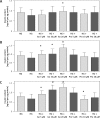Stimulation of β-adrenergic receptors plays a protective role via increased expression of RAF-1 and PDX-1 in hyperglycemic rat pancreatic islet (RIN-m5F) cells
- PMID: 28261303
- PMCID: PMC5332455
- DOI: 10.5114/aoms.2016.64131
Stimulation of β-adrenergic receptors plays a protective role via increased expression of RAF-1 and PDX-1 in hyperglycemic rat pancreatic islet (RIN-m5F) cells
Abstract
Introduction: It is a widely held view that a progressive reduction of beta-cell mass occurs in the progression of diabetes. RAF-1 kinase and pancreas duodenal homeobox 1 (PDX-1) are major factors that promote survival of cells and maintain normal insulin functions. In this study we investigated the effect of a β-adrenergic receptor agonist and antagonist on RAF-1 and PDX-1, and their respective effects on apoptosis and insulin release in RIN-m5F cells.
Material and methods: RIN-m5F cells were cultured in normal (5 mM) and high (25 mM) glucose to mimic diabetic conditions, followed by treatment with 5 µM, 10 µM and 20 µM of isoproterenol and isoproterenol + propranolol for 6, 12 and 24 h. Western blotting and reverse transcription analysis were performed to examine the expression of RAF-1 and PDX-1. Annexin-V-FITC and terminal deoxynucleotidyl transferase dUTP nick-end labeling (TUNEL) assays were used to investigate apoptosis. ELISA was used to measure insulin levels. Reverse transcription polymerase chain reaction was conducted to investigate the expression of genes.
Results: Stimulation of β-adrenergic receptors with isoproterenol significantly induced RAF-1 and PDX-1 genes in a concentration-dependent and time-independent manner. Changes were significant both at protein and mRNA levels. Up-regulation of RAF-1 and PDX-1 was accompanied by improved insulin levels and reduced apoptosis. Concentrations of 10 µM and 20 µM for 12 and 24 h were more effective in achieving significant differences in the experimental and control groups. Propranolol reversed the effect of isoproterenol mostly at maximum concentrations and time periods.
Conclusions: A positive effect of a β-adrenergic agonist on RAF-1 and PDX-1, reduction in β-cell apoptosis and improved insulin contents can help to understand the pathogenesis of diabetes and to develop novel approaches for the β-cell dysfunction in diabetes.
Keywords: apoptosis; hyperglycemia; insulin; pancreas duodenal homeobox 1; v-raf-leukemia viral oncogene 1; β-adrenergic receptors.
Conflict of interest statement
The authors declare no conflict of interest.
Figures







Similar articles
-
Effect of nicotinamide mononucleotide on insulin secretion and gene expressions of PDX-1 and FoxO1 in RIN-m5f cells.Zhong Nan Da Xue Xue Bao Yi Xue Ban. 2011 Oct;36(10):958-63. doi: 10.3969/j.issn.1672-7347.2011.10.005. Zhong Nan Da Xue Xue Bao Yi Xue Ban. 2011. PMID: 22086006
-
Emulsified isoflurane protects beta cells against high glucose-induced apoptosis via inhibiting endoplasmic reticulum stress.Ann Palliat Med. 2020 Jan;9(1):90-97. doi: 10.21037/apm.2019.11.31. Ann Palliat Med. 2020. PMID: 32005067
-
AMP-activated protein kinase and pancreatic/duodenal homeobox-1 involved in insulin secretion under high leucine exposure in rat insulinoma beta-cells.J Cell Mol Med. 2009 Apr;13(4):758-70. doi: 10.1111/j.1582-4934.2009.00656.x. J Cell Mol Med. 2009. PMID: 19438972 Free PMC article.
-
Pancreatic Duodenal Homeobox (PDX-1) in health and disease.J Pediatr Endocrinol Metab. 2002 Nov-Dec;15(9):1461-72. doi: 10.1515/jpem.2002.15.9.1461. J Pediatr Endocrinol Metab. 2002. PMID: 12503852 Review.
-
PDX-1 and the pancreas.Pancreas. 2004 Mar;28(2):109-20. doi: 10.1097/00006676-200403000-00001. Pancreas. 2004. PMID: 15028942 Review.
Cited by
-
Possible association of arrestin domain-containing protein 3 and progression of non-alcoholic fatty liver disease.Int J Med Sci. 2019 Jun 2;16(7):909-921. doi: 10.7150/ijms.34245. eCollection 2019. Int J Med Sci. 2019. PMID: 31341404 Free PMC article.
-
Secondary diabetes mellitus in pheochromocytomas and paragangliomas.Endocrine. 2023 Dec;82(3):467-479. doi: 10.1007/s12020-023-03492-7. Epub 2023 Sep 20. Endocrine. 2023. PMID: 37731140 Free PMC article. Review.
-
Eugenosedin-A improves glucose metabolism and inhibits MAPKs expression in streptozotocin/nicotinamide-induced diabetic rats.Kaohsiung J Med Sci. 2018 Mar;34(3):142-149. doi: 10.1016/j.kjms.2017.11.003. Epub 2017 Nov 29. Kaohsiung J Med Sci. 2018. PMID: 29475461 Free PMC article.
-
Mechanisms of β-adrenergic receptors agonists in mediating pro and anti-apoptotic pathways in hyperglycemic Müller cells.Mol Biol Rep. 2022 Oct;49(10):9473-9480. doi: 10.1007/s11033-022-07816-0. Epub 2022 Aug 4. Mol Biol Rep. 2022. PMID: 35925485
-
Comparative Study of Two Common In Vitro Models for the Pancreatic Islet with MIN6.Tissue Eng Regen Med. 2023 Feb;20(1):127-141. doi: 10.1007/s13770-022-00507-8. Epub 2023 Jan 2. Tissue Eng Regen Med. 2023. PMID: 36592326 Free PMC article.
References
-
- David EL, Hanna-Maaria L, Leo KN, George AK, Jukka TS, Timo AL. Metabolic syndrome and development of diabetes mellitus: application and validation of recently suggested definitions of the metabolic syndrome in a prospective cohort study. Am J Epidemiol. 2002;156:1070–7. - PubMed
-
- Theodosios DF, Evangelos CR, Irene FG, et al. Differences in metabolic parameters and cardiovascular risk between American Diabetes Association and World Health Organization definition of impaired fasting glucose in European Caucasian subjects: a cross-sectional study. Arch Med Sci. 2013;9:788–95. - PMC - PubMed
-
- Eizirik D, Mandrup-Poulsen T. A choice of death-the signal-transduction of immune-mediated beta-cell apoptosis. Diabetologia. 2001;44:2115–33. - PubMed
-
- Sakuraba H, Mizukami H, Yagihashi N, Wada R, Hanyu C, Yagihashi S. Reduced beta-cell mass and expression of oxidative stress-related DNA damage in the islet of Japanese type II diabetic patients. Diabetologia. 2002;45:85–96. - PubMed
LinkOut - more resources
Full Text Sources
Other Literature Sources
Research Materials
Miscellaneous
